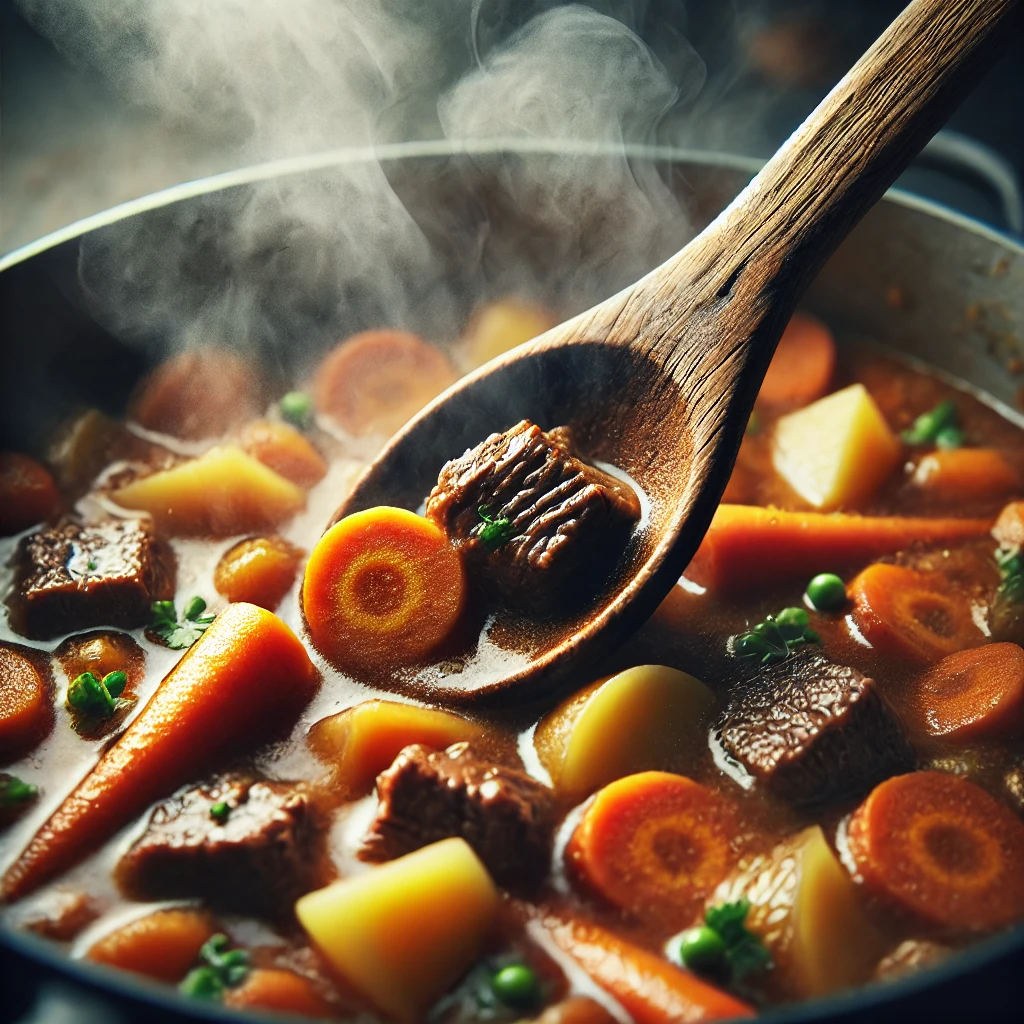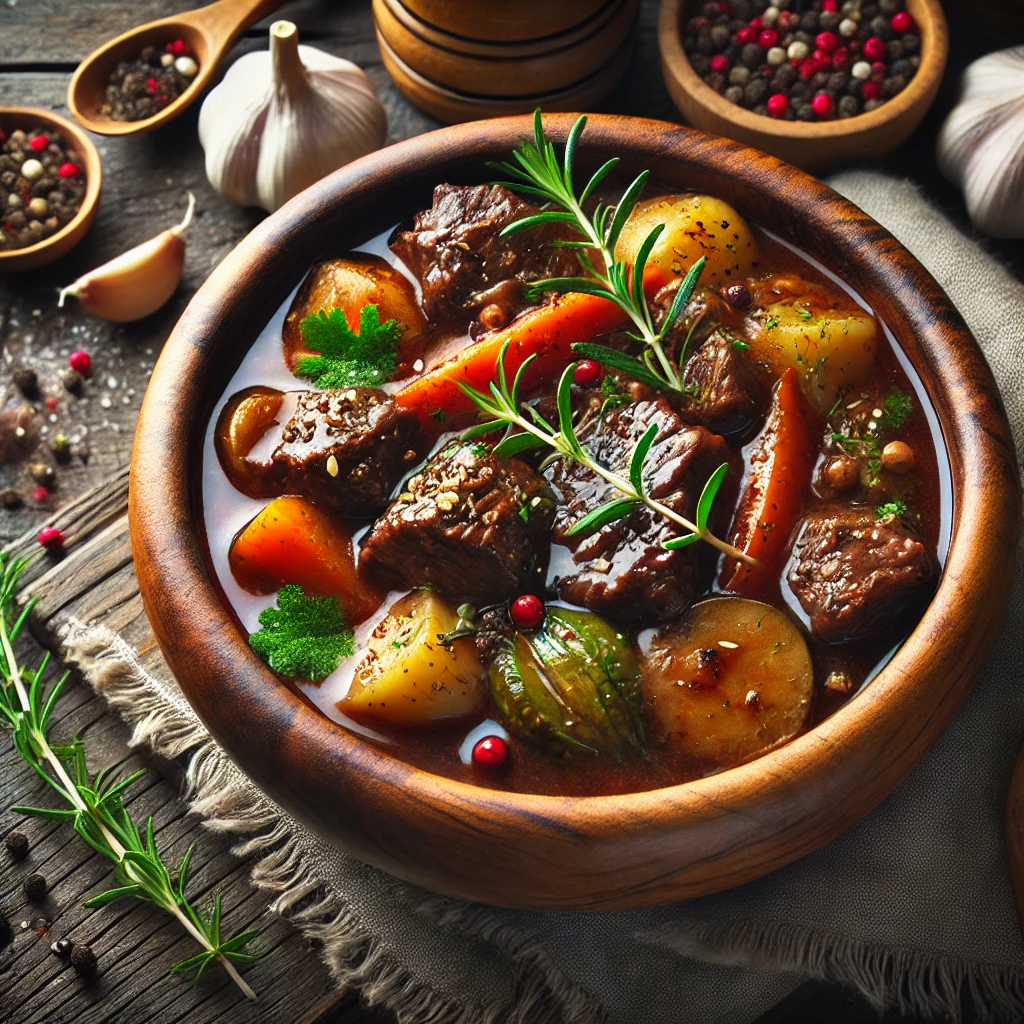Table of contents
- Introduction
- Essential Elements of a Perfect Stew
- How to Use Secret Ingredients Effectively
- Timing is Everything
- Pairing Flavors with Other Ingredients
- Enhancing Complexity Without Overdoing It
- Taste and Adjust Frequently
- 1. What is the secret ingredient in a stew?
- 2. How do I fix a bland stew?
- 3. Can I make a rich stew without alcohol?
- 4. Are sweet ingredients necessary for beef stew?
- 5. How do I balance flavors in a stew?
- 6. Can I use pre-mixed spice blends for beef stew?
- 7. What vegetables enhance the flavor of beef stew?
- 8. How do I know when to add secret ingredients?
- 9. Can I make beef stew ahead of time?
- 10. How do I make beef stew thicker?
- Conclusion: Elevate Your Stew with Secret Ingredients
Introduction
Beef stew is a dish that’s loved for its rich flavors, hearty ingredients, and comforting appeal. While a good stew relies on the basics—tender beef, vegetables, and a flavorful broth—what truly makes a stew memorable is the addition of a secret ingredient. These special touches transform an ordinary dish into something extraordinary, leaving everyone asking for the recipe.
When crafting the perfect beef stew seasoning recipe, the right secret ingredient can elevate the dish, enhancing its depth, aroma, and overall complexity. In this article, we’ll explore what secret ingredients work best in stew, how they enhance flavor, and tips for using them effectively.
Essential Elements of a Perfect Stew
A delicious beef stew starts with the right foundation. Before we dive into the magic of secret ingredients, it’s essential to understand the core components that form the base of a perfect stew.
The Base Flavors
- Beef Broth:
- The heart of any beef stew, a rich broth provides the savory depth that defines the dish. Using homemade beef stock or high-quality store-bought broth ensures a strong, flavorful base.
- Vegetables:
- Traditional choices like carrots, celery, onions, and potatoes not only add texture but also release natural sweetness into the broth.
- Seasonings:
- Salt and black pepper are essential for enhancing flavors. A pinch at the start and adjustments throughout cooking ensure a balanced taste.
Classic Spices

- Thyme:
- Adds an earthy, aromatic note that complements the beef and vegetables.
- Paprika:
- Sweet or smoked paprika contributes color and a mild spiciness to the broth.
- Bay Leaves:
- These provide a subtle herbal warmth and bind the flavors together.
Pro Tip: Use fresh herbs for garnish at the end to bring brightness to the finished dish.
Importance of Balance in Seasoning
Achieving balance is key when seasoning beef stew. Here’s how to manage it:
- Salt: Enhances the natural flavors of the beef and vegetables.
- Acidity: Ingredients like tomatoes or vinegar brighten the dish and cut through richness.
- Sweetness: A touch of sweetness from vegetables or ingredients like honey balances the savory notes.
When these elements work together, they create a stew that’s satisfying and well-rounded. Once the base is perfected, it’s time to explore the magic of secret ingredients!
What Is the Secret Ingredient in a Stew?
A secret ingredient is the one unexpected addition that elevates a stew from good to unforgettable. These ingredients amplify flavor, add complexity, and make the dish stand out. Let’s explore some of the best secret ingredients you can use in beef stew.
Umami-Rich Ingredients

- Worcestershire Sauce:
- A small splash adds tangy, savory depth. Its fermented flavor enhances the natural richness of the beef.
- Soy Sauce:
- Adds a salty, umami boost without overpowering the dish. Use low-sodium soy sauce to maintain balance.
- Tomato Paste:
- A tablespoon of tomato paste sautéed with garlic or onions creates a caramelized base for a richer broth.
- Anchovy Paste:
- Though unconventional, anchovy paste dissolves into the broth, leaving behind a deep, savory flavor without a fishy taste.
Sweet Notes for Balance
- Honey or Brown Sugar:
- A touch of sweetness balances the acidity of tomatoes or wine in the stew, creating a harmonious flavor profile.
- Maple Syrup:
- Especially effective in stews with root vegetables, maple syrup adds a subtle caramelized sweetness.
Pro Tip: Start with a small amount of sweet ingredients and adjust gradually to avoid overpowering the dish.
Bold and Unique Additions
- Red Wine:
- A classic addition, red wine adds depth, acidity, and a touch of elegance. Use a dry wine like Cabernet Sauvignon or Merlot for the best results.
- Balsamic Vinegar:
- A splash of balsamic vinegar towards the end of cooking brightens the stew and enhances its complexity.
- Dark Chocolate:
- A small square of dark chocolate melts into the stew, adding richness and a subtle bittersweet flavor. This works particularly well in stews with tomato-based broths.
Aromatic Enhancers
- Fresh Herbs:
- Adding parsley, cilantro, or dill just before serving enhances the stew’s aroma and provides a burst of freshness.
- Lemon Zest or Juice:
- A small amount of zest or juice cuts through the stew’s richness and balances heavy flavors.
How to Choose Your Secret Ingredient
- Consider the Base Flavor:
- If your stew is tomato-based, add something sweet or umami-rich, like honey or Worcestershire sauce.
- For a broth-based stew, bold ingredients like balsamic vinegar or red wine shine.
- Balance is Key:
- Use secret ingredients in moderation to complement, not overpower, the other flavors.
- Experiment:
- The best way to find your signature touch is by trying different ingredients and tasting as you go.
How to Use Secret Ingredients Effectively
Incorporating secret ingredients into beef stew requires thoughtfulness and precision. Using them correctly ensures they enhance the flavor without overpowering the dish. Follow these strategies for optimal results.
Timing is Everything
- Add Early for Depth:
- Ingredients like tomato paste, soy sauce, and Worcestershire sauce should be added early in the cooking process.
- This allows them to meld with the broth, creating a rich base.
- Finish with Brightness:
- Ingredients like balsamic vinegar, lemon zest, or fresh herbs should be added towards the end of cooking.
- This maintains their vibrant flavors and prevents them from becoming muted.
- Gradual Adjustment:
- For potent ingredients like dark chocolate or anchovy paste, add small amounts at a time. Taste frequently to ensure balance.
Pairing Flavors with Other Ingredients
- Complementary Flavors:
- Sweet ingredients like honey or maple syrup pair well with acidic components like tomatoes or wine.
- Umami boosters like soy sauce or anchovies work best with earthy flavors like thyme and rosemary.
- Avoid Clashing Tastes:
- Strong flavors, such as balsamic vinegar and cinnamon, should be used sparingly to avoid overpowering the dish.
Enhancing Complexity Without Overdoing It
- Layer Flavors:
- Build complexity by adding ingredients at different stages of cooking. For example:
- Start with tomato paste during sautéing.
- Add soy sauce when simmering the broth.
- Finish with fresh herbs before serving.
- Build complexity by adding ingredients at different stages of cooking. For example:
- Balance Sweetness and Acidity:
- If the stew is too sweet, balance it with a splash of vinegar or lemon juice.
- If it’s too acidic, a touch of honey or brown sugar can mellow the flavors.
Taste and Adjust Frequently
- Continuous Tasting:
- Regularly taste the stew as it simmers to catch imbalances early.
- Final Check:
- Just before serving, do a final taste test to adjust salt, pepper, and acidity. A small tweak can make a big difference.
By following these tips, you can use secret ingredients effectively to create a stew that’s flavorful, well-balanced, and uniquely yours. Up next, we’ll address frequently asked questions about enhancing beef stew, ensuring you have all the information you need to master this dish.
Frequently Asked Questions (FAQs)
1. What is the secret ingredient in a stew?
The secret ingredient can vary depending on the flavor profile you want to achieve. Common choices include Worcestershire sauce for umami, balsamic vinegar for brightness, or dark chocolate for a touch of richness.
2. How do I fix a bland stew?
To add depth to a bland stew:
- Incorporate umami boosters like soy sauce, Worcestershire sauce, or tomato paste.
- Add acidity with balsamic vinegar, red wine, or lemon juice.
- Adjust seasoning with salt, pepper, and fresh herbs.
3. Can I make a rich stew without alcohol?
Yes, you can! Substitute red wine with balsamic vinegar or pomegranate juice for acidity and depth. Worcestershire sauce or soy sauce can also add umami without the need for alcohol.
4. Are sweet ingredients necessary for beef stew?
Sweet ingredients like honey or brown sugar aren’t necessary but can balance acidity in tomato-based stews. A small amount goes a long way in enhancing overall flavor.
5. How do I balance flavors in a stew?
- Too Sweet? Add a splash of vinegar or lemon juice.
- Too Salty? Dilute with water or broth, or add a potato to absorb excess salt.
- Too Acidic? Stir in a pinch of sugar or a dollop of cream.
6. Can I use pre-mixed spice blends for beef stew?
Yes, pre-mixed spice blends like Italian seasoning or herbes de Provence can simplify preparation. Just ensure the blend complements the stew’s other flavors and adjust the salt to avoid over-seasoning.
7. What vegetables enhance the flavor of beef stew?
Carrots, celery, onions, and potatoes are classic choices. Parsnips and leeks add sweetness, while mushrooms bring an earthy, umami flavor to the broth.
8. How do I know when to add secret ingredients?
- Add rich, umami-based ingredients (e.g., Worcestershire sauce or soy sauce) early.
- Add bright and delicate ingredients (e.g., balsamic vinegar, lemon zest, or fresh herbs) towards the end of cooking.
9. Can I make beef stew ahead of time?
Absolutely! Beef stew often tastes better the next day as the flavors meld together. Store it in an airtight container in the refrigerator for up to 3 days or freeze it for longer storage.
10. How do I make beef stew thicker?
- Use a cornstarch slurry (1 tablespoon cornstarch mixed with 2 tablespoons water).
- Mash some of the potatoes or vegetables into the broth.
- Let the stew simmer uncovered to reduce the liquid naturally.
Conclusion: Elevate Your Stew with Secret Ingredients
The secret ingredient in a stew can turn a simple recipe into a culinary masterpiece. Whether you choose Worcestershire sauce for umami, balsamic vinegar for brightness, or dark chocolate for richness, these additions bring depth and character to the dish.
By experimenting with flavors and using secret ingredients effectively, you can create a stew that’s uniquely yours—one that will leave your guests guessing what makes it so special.
Happy cooking, and may your stews always be full of flavor and warmth!

